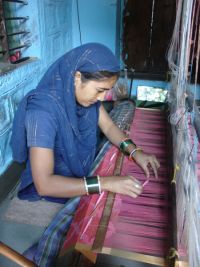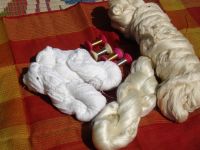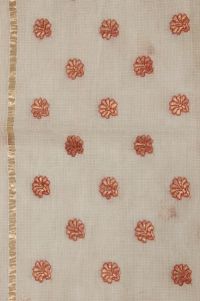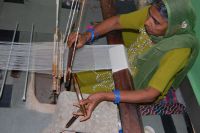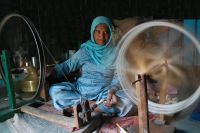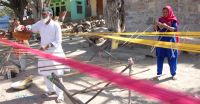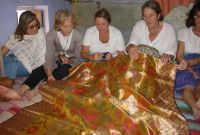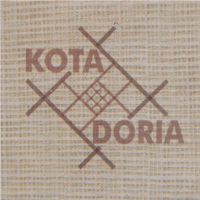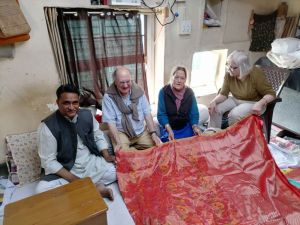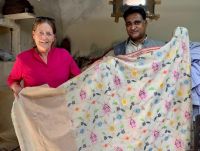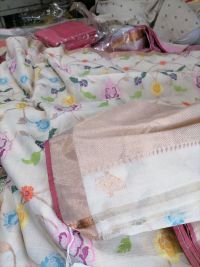Kota doria - Unique Summer Weave
(Click on an image to enlarge)
Badrun Nisha is Secretary of the Kota Women Weavers Organisation (KWWO) which has 155 members. Her family is one of the estimated 3000 families involved in handloom weaving in Kaithoon, a small town 15 kms from Kota in SE Rajasthan, India.
The handloom business is controlled by about 45 male master weavers and the one women’s cooperative. Most of the weavers are now female and there are an estimated 1500 looms in Kaithoon. Others are involved in associated activities such as setting up and repairing looms, production and dying of yarn and so forth. The industry is still economically independent and is not run by NGOs which have a peripheral role in for example helping with design, management training and health care.
Kaithoon, with one or two villages locally, is now the only area where kota doria is woven. Doria means thread. By combining cotton and silk yarns the distinctive fine check pattern resembling translucent graph paper is produced. Cotton provides strength and durability and silk ensures its softness and delicate feminine qualities. It is the ideal fabric for hot and humid weather and is said to have been found in Mysore in South India by Rao Kishore Singh of Kotah when campaigning for the Mughal Emperor Aurangzeb in the mid seventeenth century. He introduced weavers from Mysore to his state and the new weave first came to be known as kota mysoria.
Doria fabric is embellished with borders and small decorative patterns called buties woven in using cotton, silk, silver or golden thread. Gold and silver threads are called zari. Zari is made from a mixture of metals including 5% real gold on a red silk thread. It is very expensive but the Kaithoon weavers only use pure zari so as not to devalue the product. Cheaper power loom imitations using artificial zari now dominate the market.
Rubina is weaving fabric for a 20 yard long turban on a narrow loom. Kota doria may have first been used for the Kotah style paag or male headwear and then the looms were gradually widened to weave broader fabric for the half -saris or odhanis, worn over long skirts called lehangas. Finally, one piece saris of 46 inches in width and 5.5 yards or 5meters in length became fashionable and they are now the mainstay of the industry.
You can see the pit in the floor from where Rubina is controlling the loom using two wooden circles on strings held between her toes like flip-flops of chappals.
Rubina’s husband set her up with a grocery store but after fifteen years she returned to weaving for pleasure and for the independence it gives her. She is one of the very few weavers remaining who weave the traditional paag.
Aabida Banu is Badrun’s mother-in-law. She has been weaving since she was 10. She taught her daughters to weave and at their marriages they were given a loom each and were married into other weaving families in the town. Her daughters-in-law now weave in her house and this younger generation has also been to school. Aabida Banu now concentrates on winding the mill prepared yarn onto spindles.
Women of all ages participate in the weaving processes and so that all contribute economically to the family income.
The weavers of Kaithoon belong to the Muslim Ansari community. Making doria is a skilled and very labour intensive process and the whole family is involved. Weaving empowers women and give them status in the community. They have a way of supporting themselves and their families which is skilled and dignified and in which they can combine household jobs with income generation.
As the power loom kota doria saris from Varanasi, Kolkatta and China take over the market for simple cotton saris and dupattas, the hand loom industry is trying to re-position itself at the top end of the market by designing and weaving gorgeous tissue wedding saris, heavy with gold zari . The market for these saris is largely in South India centered at Hyderabad. These intricate saris take a month to weave and each one is a unique work of art that can be treasured for generations as the real zari will not tarnish.
Hand weaving, in any form, is time consuming and expensive but kota doria is a unique highly skilled craft that has developed over centuries. For the Ansari women weavers of Kaithoon, weaving is a way of life that is empowering and rewarding and they request you to support their efforts to keep this ancient craft viable and vibrant. Look for this trade mark before buying.
Innovation in Kota Doria
***********************************************************************
The traditional mix for many years has been approximately 80% cotton and 20% silk. Tussar silk is sometimes used but usually mulberry silk. The weavers are innovating all the time with increasingly complex patterns and larger and larger motifs
By contrast, this by Asgar Ali is a 100% cotton Kota doria sari, with floral pattern woven on a jaal loom in Jamdani style, detailed with a zari border and pallu.

